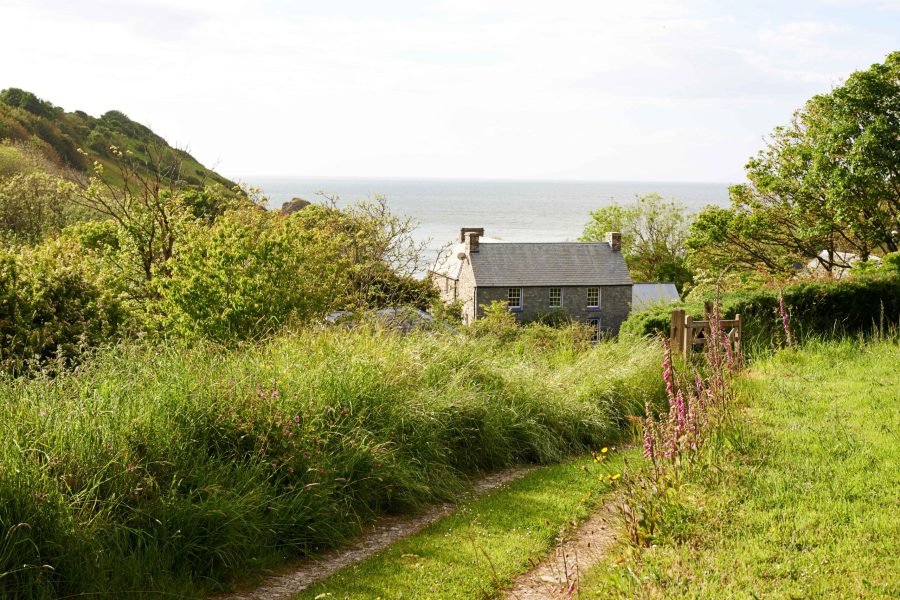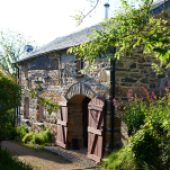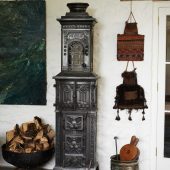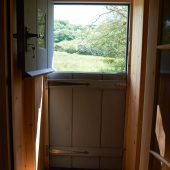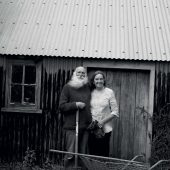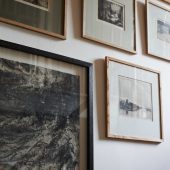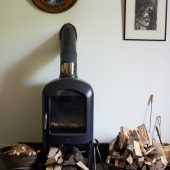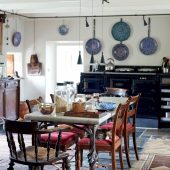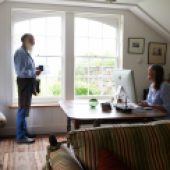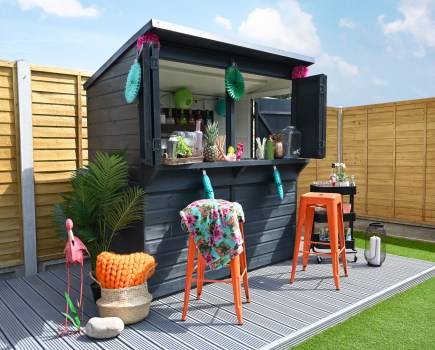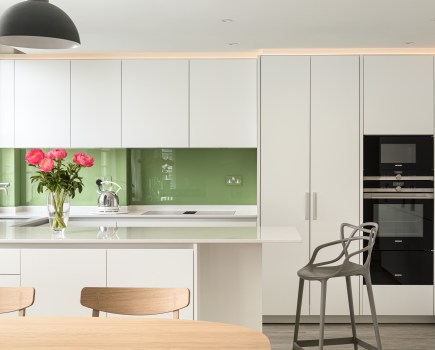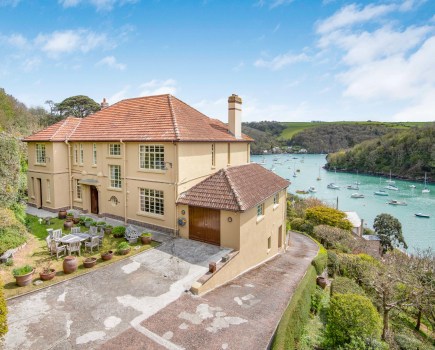How Jo Reid and John Peck breathed life back into a homestead and water mill on the Pembrokeshire coast, with a keen sense of history and a team of local craftspeople. Words: Alex Reece. Photographs: Paul Viant
‘It was just one of those mad moments,’ says Jo Reid of the day she and partner John Peck came across a dilapidated 18th-century homestead and derelict water mill near Fishguard on the Pembrokeshire coast.
Jo, an architectural photographer, and John, her assistant, just happened to be working in Pembrokeshire – a place where they both have friends and happy childhood memories of the seaside – when Jo’s mother called to tell them about the property, which she’d spotted in the newspaper. Keen to leave the recession-hit capital of the early Nineties, they decided to take a look, but, having just completed a 20-year renovation on their house in East London, they were not looking for another arduous project.
‘It wasn’t practical,’ continues John. ‘Every building was basically wrecked and in need of severe attention. There was no garden, either. But they were essentially lovely buildings. We can always see through that, to what one could do with it.’ And then there was the heart-stopping hillside setting, with direct views of the sea, and a footpath leading from the house down to a small, pebbled cove. Says Jo: ‘I was in love at the top of the lane.’
RAISING THE ROOF
What followed was a restoration project on an epic scale – starting with emergency remedial work on the water mill, while Jo and John were still based in London. With the help of a grant from Welsh heritage body Cadw, which had Grade II-listed the whole site, they were able to eradicate a serious case of dry rot and bring the mill back to serviceable life (Jo and John occasionally open it to the public in return for donations towards its ongoing upkeep).
When Jo and John finally left the capital two years later, in 1995, they moved into the main house and began converting the cottage (originally a barn and granary) into hostel accommodation for walkers. This job was the start of an ongoing design collaboration with a team of local craftsmen. Village blacksmith Eifion Thomas, for example, made the six iron guest beds, ‘which was a big surprise for everybody,’ says John. ‘Some of the things we’ve done are because we’ve met him.’
The couple ran the hostel for three years, happy to leave their home unrenovated while they got the business off the ground. ‘There were strange wallpapers, damp and mould everywhere, and polystyrene tiles stuck on the ceiling upstairs,’ recalls John. ‘The front door, we knew, if we opened it would fall off.’ They had only just begun removing the render from the exterior walls when disaster struck, and the roof blew off in a fierce gale. ‘I think it was more shocking for the neighbours,’ laughs Jo, ‘because we got this phone call early in the morning, saying: ‘Are you all right? I can see this enormous hole in your roof!’’ The two of them had no choice but to close the hostel, move into it, and rescue the house.
PAST AND PRESENT
It was a huge job, which they worked on more or less full-time for five years, doing as much of the labour as possible with the support of local tradesmen. ‘We stripped it out entirely,’ says John. ‘We were able to leave most of the joists, but replaced all the windows and doors and all of the plaster on the walls.’ Though the stone structure remained pretty much intact, the interior layout of the ground floor was altered to create a suite of guest rooms (a sitting room, bedroom and en suite) at the front of the house, and a large kitchen/diner to the rear. In the footprint of a tumbledown shed, the couple built what they call ‘the sea room’ – a further sitting room that now leads off the kitchen – providing a front-row view of the waves.
The pair’s painstaking attention to detail and desire to stay true to Pembrokeshire vernacular architecture is evident in the newly hung, graded-slate roof with the tiles diminishing in size as the roof gets higher, and the pin-sharp joinery. It is also true of the sensitive landscaping of the 5½-acre site. By researching old maps, Jo and John found the whereabouts of the original mill pond and had it dug out to reinstate it as the reservoir for the waterwheel. The waterfall, which now flows from the pond, was Jo’s idea, brought to fruition by stonemason Gareth Roberts.
An additional responsibility that came with the land was the public footpath that leads through it down to the beach. ‘There are huge plusses to having it,’ agree Jo and John. ‘It was our main way of meeting people when we first came here.’ But to discourage a minority of walkers who would ‘pop their noses against the window and look in’, says Jo, they commissioned Gareth Roberts to build an attractive courtyard wall, made of reclaimed local stone, to shield the kitchen windows from view.
A LABOUR OF LOVE
The final phase of work, recently completed, has involved remodelling the former walkers’ hostel into a smart holiday cottage, called Felin Hescwm. The name means ‘mill in a sedge valley’ in Welsh. By reversing the levels of the living and sleeping areas, Jo and John have opened up the original granary floor upstairs to create an open-plan kitchen/diner and sitting room, with cupboards and units by carpenter Rob Bisset. A wrought-iron balcony, built by the blacksmith, adjoins the kitchen, giving views of the sea. And a smooth stone staircase, handmade from Welsh billiard slate by stonemason Jim Ashe, winds down to two en-suite bedrooms at ground level.
Of course, with a historic property like this, some jobs are never finished: the mill wheel needs re-bucketing every 15 years and the mill pond has to be kept clear of silt. But, despite the huge amount of work involved and the occasional crises they have encountered, Jo and John are adamant that it has all been worth it. ‘We worked very long hours in London and we had a very stressful life,’ says John. ‘So working down here, although it had its own stresses, was less intense than what we’d had, and it was creatively very satisfying.’
What’s more, they are now based in a beautiful place, where kingfishers and otters frequent the mill pond and stream, and, when they go out on their canoe in Fishguard Bay, they’re often accompanied by dolphins.
‘We’re so privileged to live here,’ says Jo. ‘We have built stone seats in our favourite spots on the land, where we love to sit and chat, and watch the sun go down over the sea.’
Felin Hescwn is available to rent at here.
Jo and John's renovation tips
• To undertake a renovation project of this scale, you need to be good in adversity, to be willing to keep going and not want it finished in five minutes. Some people can’t function unless things are nice and tidy, but it takes time to get the feel of a building and how it might work for you.
• When converting a farm building, be aware that it wasn’t built to be a home. It’s great that these buildings are finding a new use, but it does have its problems
and it takes a lot of thought.
• If you’re working with a stone structure, it’s essential to use lime rather than cement. Lime is totally porous, so it allows the walls to breathe and dry out completely.
• Financially, the trouble with renovation is that you find things you can’t plan for and they end up costing more than you think. We had a few low points, but life’s like that.
• The high points are one’s dreams coming into fruition. You work out how it could be, then you slowly put it together, and when it’s finally realised, it’s very exciting.

